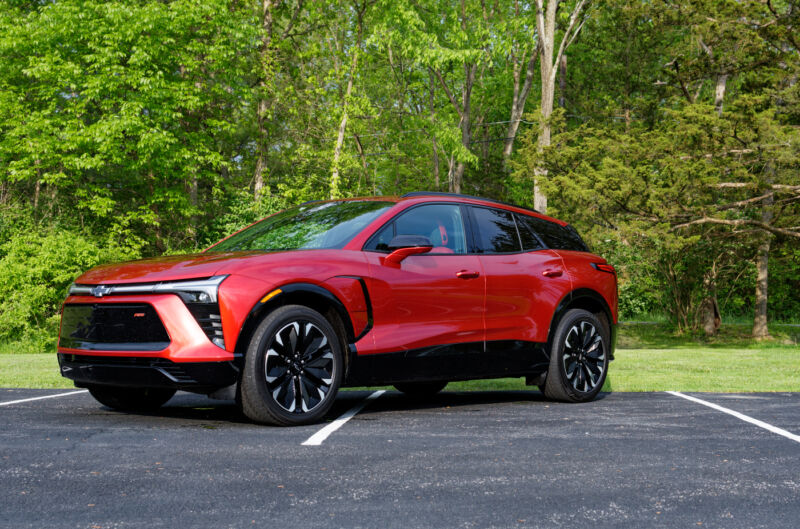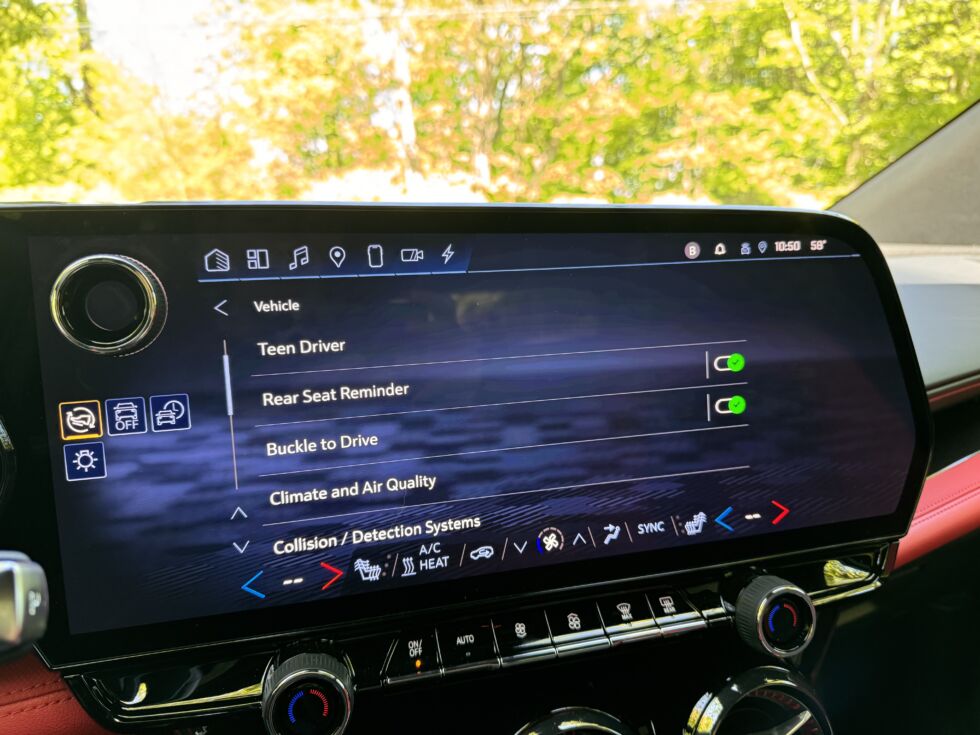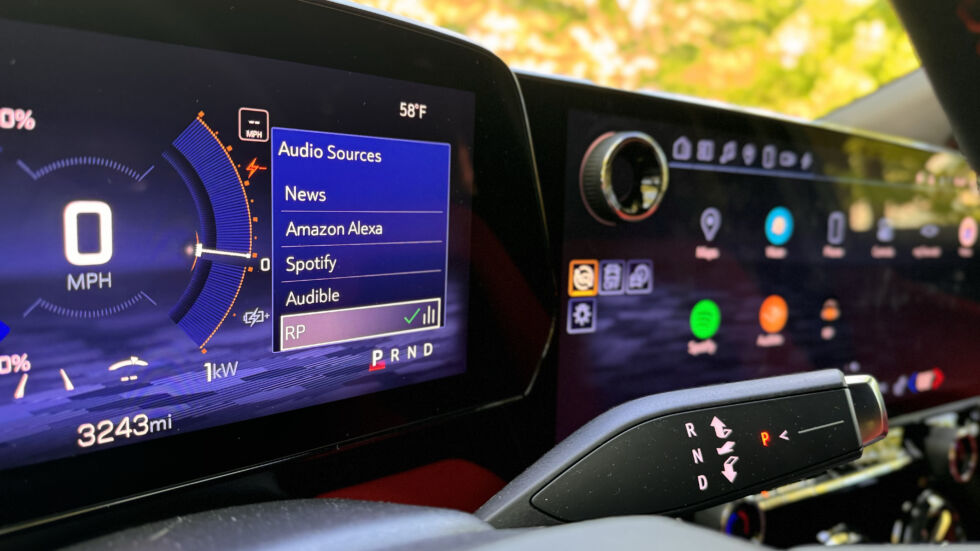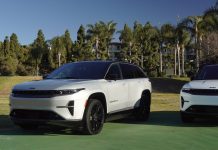The decision to drop Apple CarPlay was a mistake.

General Motors appears to have solved the problem that was holding back the production of its Ultium-based electric vehicles. These are now rolling out of factories—you can expect to read about the new Silverado EV tomorrow and the (allegedly affordable) Equinox EV next week, to name but two. We got a first-blush drive of the Blazer this past winter before GM had to put a stop on sales due to some… glitches. Now, with the vehicle back on sale and the software debugged, it’s time to see if the fixes helped.
In reintroducing the Blazer EV and returning it to market, Chevy has also lowered the price pretty significantly, by an average of about $6,000 per model. The LT AWD now starts at $48,800, and there’s a $7,500 incentive for customers who aren’t eligible for the IRS clean vehicle tax credit. The RS AWD, which we tested, has an MSRP of $53,200, but with the delivery charge and GM’s cash on the hood, it came in at $47,095. Both have an 85 kWh battery good for 279 miles (449 km) max range per charge. The longer-range, bigger-battery 102 kWh RS RWD boasts a more impressive 324 miles ( 521 km) per charge and works out to $48,670.
These are pretty competitive prices when you consider the mid-sized EV SUV segment. An obvious comparison: The Ioniq 5 SE AWD costs $49,350 and cannot qualify for the federal tax credit (unless leased), and its range runs shy of the Chevy Blazer RS AWD, too, at 260 miles (418 km) versus the Chevy’s 279.
The Ioniq 5 is a pretty good comparison, too, in terms of being a wagon-ish ride, which is about where the Blazer lands. The Hyundai is too low to think of as an SUV, and ditto the Chevy. Both are very close in terms of interior dimensions, with almost the same hip, shoulder, and legroom front and rear—although if you get the sunroof package on the Blazer, rear seat headroom gets pinched pretty significantly. Our tester didn’t have a sunroof, and six-footers could sit back there without scraping their scalps.

The seats in the Blazer EV are surprisingly good. In fact, it was just a darn fine vehicle in terms of driving comfort, in marked contrast to the models we tested in December. Those cars may have suffered from preproduction glitches, but the Blazer EV RS we just spent a week with is comfortable for both fore and aft passengers over long distances, with about the only demerit that the 21-inch wheels feel as big as they are, so there’s a deadness to the steering. Also, if you’re still cross-shopping that Hyundai, the Ioniq 5 is a significantly lighter car, weighing 4,519 lbs (2,050 kg) vs. 5,337 lbs (2,421 kg) for the Blazer RS, and the driver will feel that weight in the form of sluggish transitions through tight corners. The RS stands for “Rally Sport,” via cars like the Camaro, but this isn’t a rig you want to “rally.”
But that’s fine. The Blazer EV is a family car, and as such, it’s pretty great, with 25.5 cubic feet (722 L) of cargo capacity with the rear seatbacks upright, and 59.1 cubic feet (1,673 L) with them flipped forward. The Ioniq 5 offers a couple of cubic feet more cargo volume than the Blazer EV with the rear seats in use, and with the Ioniq 5’s seats folded, it’s basically a wash.
The Chevy Blazer RS AWD EV delivers 288 hp (212 kW) and 333 lb-ft (451 Nm). This feels plenty muscular, if not “blazing,” with 0–60 mph times reported in the six-second range. However, the Ioniq 5 SE’s 320 hp (239 kW) and 446 lb-ft (605 Nm) make that car quite quick indeed, and right on the heels of the other elephant in the family-car throwdown, the Tesla Model Y.
Driving isn’t the issue—the tech is

It’s important to mention the Tesla Model Y because that’s another EV that doesn’t bake in Apple CarPlay or Android Auto. Tesla fans tend not to gripe about this, in part because the software in Teslas is very streamlined and pared back. It’s not lovable, but it’s not hard to pair a phone and play what’s on there. By contrast, one reason GM had to yank the cord on sales of the Blazer was that the car’s software was exceedingly glitchy; this wasn’t about GM switching to its proprietary Ultifi UI but that it wasn’t working. For our test drive week, it worked as promised—just not in a way that argues well for eliminating Android Auto or Apple CarPlay.
When GM went to its Ultifi system and ditched Apple CarPlay and Android Auto, the argument was supposedly in part about driver control and using the vehicle’s native UI vs. Apple’s. But if the native UI is worse than Apple’s, you have a problem. And both Android Auto and CarPlay—which are just constrained versions of their phone UIs—have been refined through testing with billions of consumers over hundreds of millions of combined hours of use. No carmaker can make anything like that claim about their in-house UI. Megacorp tech giants are by no means the answer to our prayers, but there is a reason these platforms have gained so much ground as infotainment structures in our cars and homes.
And you can get an “exhibit A” for why that matters when you try to tee up an audio source when driving the Blazer EV.
ARS VIDEO
What Happens to the Developers When AI Can Code? | Ars Frontiers
The main interface uses a touchscreen and a top menu bar of icons, including a musical note. You’d probably guess that tapping this icon would pull up different audio sources, but it doesn’t. To find those, you instead tap the “home” icon, which shows installed apps on the Ultifi platform. Native ones include Spotify. You don’t see what’s on your paired phone, either. To play those items, you have to begin playback on your phone before driving—or be that stupid driver playing with your phone while driving.
Further, to play from apps you already have on your phone, Ultifi wants you to download redundant versions from the Google Play store (since Ultifi is based on Android Automotive OS), sign in, hum a song or three or read a few pages of a book while the content caches, and so on. You have to go through all the perambulations required to access your phone’s content in the car’s UI. Cue the steam pouring from your ears. How is this “better,” exactly?
Google Voice can’t fix this

In theory, some of what GM has addressed by using Google as the back-end mapping and voice control should help. But here’s the rub: GM seems to want to steer you toward native apps it already has tie-ups with, such as Spotify. Other obvious ones don’t necessarily jibe. For instance, we downloaded Audible, which works after you cache the books already on your phone. That takes a lot of time. Again, you could just stream it over Bluetooth and never download the app, but that isn’t a better customer experience than Android Auto or CarPlay provides.
And it gets worse; we use an app for music called Radio Paradise that caches high-bitrate audio to your phone, since that delivers superior playback to satellite radio. Unfortunately, when downloaded to the Blazer, this would only yield one of the many Radio Paradise channels rather than the several options already on our test phones. Further, back to the navigation issue, using Google Voice to switch audio sources only works with some of the apps. Spotify is fine. Audible worked, mostly, but not always. And Radio Paradise did not work. Google Voice worked great to tune to radio stations, but we’re still trailing what used to be a GM default UI in 2023.Advertisement
A silver lining
One tiny ray of sunlight is that GM’s integration of Google Maps is nifty. Search any compass point for navigation and Maps surfaces the usual array of routes but also shows the car’s estimated remaining battery life and range, and also what will remain once you get back home. Pan out slightly and tap the lightning bolt icon within the Maps screen and you’ll see charging options, too, as well as the speed of charging.

This is GM harnessing the power of Google Maps to the customer’s advantage. You can well imagine the Ultifi team also learning organizational lessons for Google and Apple and figuring out how to streamline the incorporation of phone apps into the UI. Still, backward-engineering the OS to kinda-sorta simulate what’s already working well from other carmakers seems like a Sisyphean struggle. Particularly when the Honda Prologue, which is also being produced on the Ultium platform, lets you use CarPlay. And the Ioniq 5, the most logical rival to the Blazer, has both Android Auto and CarPlay.
I like the way the Blazer EV RS drives, and I think it’s well-appointed and packaged, especially as an all-around, comfy family cruiser. It’s also now pretty cost-competitive versus alternatives. But GM is handcuffing Chevy with a disadvantage to rival cars—ones GM is also manufacturing, in some cases. It doesn’t add up, and it harms an otherwise good product.




